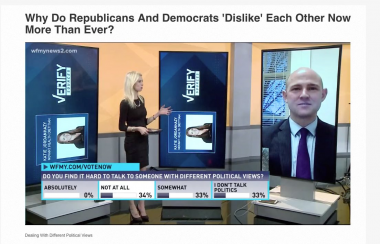WFMY News 2 turned to Jason Husser, assistant professor of political science and director of the Elon Poll, for his thoughts on how voters feel about members of the opposing political party.
Jason Husser, assistant professor of political science and director of the Elon Poll, was recently featured in a segment about the growing divide between Democrats and Republicans.
 The report by WFMY News 2, a Greensboro, N.C. CBS affiliate, stemmed from a recent CBS News poll that found that a growing segment of society has unfavorable views of the opposing political party. The poll found that in 1990, 36 percent of Americans had favorable views of both political parties, but that had fallen to just 9 percent in 2007, and has remained in that range ever since.
The report by WFMY News 2, a Greensboro, N.C. CBS affiliate, stemmed from a recent CBS News poll that found that a growing segment of society has unfavorable views of the opposing political party. The poll found that in 1990, 36 percent of Americans had favorable views of both political parties, but that had fallen to just 9 percent in 2007, and has remained in that range ever since.
"The CBS pollsters were smart in 1990 to start measuring partisan dissatisfaction," Husser said. "An older survey series from the 1940s, the American National Election Study, began detecting a pattern of discontent between parties that would grow to become the polarization we hear so much about today. Some of this partisan animosity started after Watergate, Vietnam and Stagflation in the 1970s. However, the biggest changes in attitudes since Reconstruction happened around 1994 when the GOP, led at the time by Speaker Newt Gingrich, locked horns with Democratic President Bill Clinton. We saw a brief decline in negative feelings between partisans, as captured by surveys, for a few months after the 9/11 attacks."
View the entire segment here.


